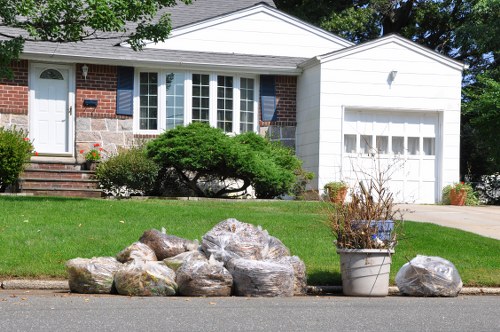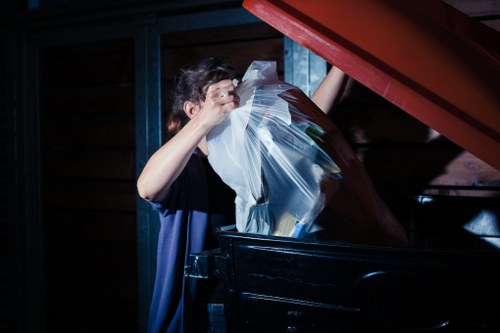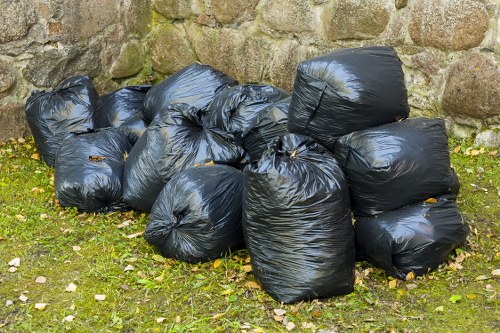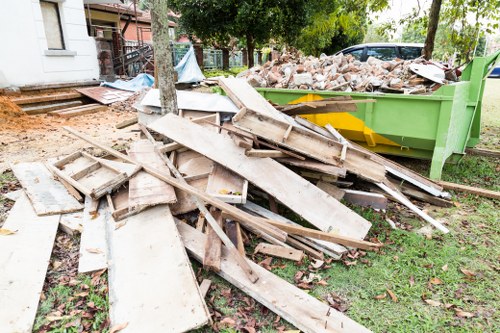White Goods Recycle in Office Clearance

In today's environmentally conscious world, businesses are increasingly mindful of their ecological footprint. One significant aspect of this responsibility is the proper disposal and recycling of office equipment, particularly white goods. White goods, which include appliances like refrigerators, microwaves, and dishwashers, are essential for office functionality but pose environmental challenges when not handled correctly.
Office clearances often involve the removal of various white goods, which, if not recycled properly, can contribute to landfill waste and environmental degradation. Implementing a robust recycling program for white goods during office clearance not only aligns with sustainability goals but also enhances a company's reputation as an eco-friendly organization.
Recycling white goods in office clearance involves several steps, from identifying recyclable items to partnering with certified recycling firms. This process ensures that appliances are disposed of responsibly, minimizing their environmental impact and potentially recovering valuable materials.

The Importance of Recycling White Goods
Recycling white goods is crucial for several reasons. Firstly, it reduces the strain on natural resources by recovering materials such as metals, plastics, and glass that can be reused in manufacturing new products. This not only conserves resources but also reduces the energy required for producing new materials.
Secondly, proper recycling helps in mitigating pollution. Many white goods contain harmful substances like refrigerants, which can damage the ozone layer if released into the atmosphere. Recycling ensures that these substances are safely handled and disposed of, preventing environmental harm.
Moreover, recycling white goods contributes to waste management efforts. With offices frequently upgrading their appliances, the volume of discarded white goods can be substantial. Efficient recycling programs alleviate the burden on landfills and promote a circular economy where products are reused and repurposed rather than disposed of.

Steps to Recycle White Goods in Office Clearance
1. Assessment and Inventory
The first step in recycling white goods during office clearance is to conduct a thorough assessment of all appliances slated for removal. Creating an inventory helps in identifying which items are recyclable and determines the best approach for their disposal.
Types of White Goods
Understanding the types of white goods in the office is essential. Common items include refrigerators, freezers, microwaves, coffee machines, and dishwashers. Each appliance may require different handling procedures depending on its components and materials.
Evaluating Condition
Assessing the condition of each appliance helps decide whether it can be refurbished, reused, or needs to be recycled. Functional items might find new life within the organization or be donated, whereas non-functional ones should be processed for recycling.

Partnering with Certified Recycling Firms
Collaborating with certified recycling firms ensures that white goods are handled in compliance with environmental regulations. These professionals have the expertise and equipment necessary to dismantle appliances safely and recover valuable materials.
When selecting a recycling partner, consider their certifications, reputation, and adherence to industry standards. A reliable firm will provide transparent processes and documentation, assuring that the recycling is conducted responsibly.
Moreover, partnering with eco-friendly recycling firms can provide additional benefits, such as potential tax incentives and enhancing the company's sustainability credentials.

Benefits of Recycling White Goods in Office Clearance
Implementing white goods recycling in office clearance offers numerous benefits. It significantly reduces the environmental impact of office waste, aligns with corporate social responsibility (CSR) initiatives, and can lead to cost savings through efficient waste management.
Environmental Impact
Recycling minimizes landfill use and decreases the demand for raw materials, thereby preserving natural resources and reducing greenhouse gas emissions associated with manufacturing new products.
Corporate Image
Companies that prioritize recycling and sustainable practices are often viewed more favorably by clients, partners, and employees. This positive image can lead to increased brand loyalty and a competitive edge in the market.
Regulatory Compliance
Proper recycling ensures that businesses comply with environmental laws and regulations, avoiding potential fines and legal issues related to improper disposal of white goods.
Implementing a Recycling Program
To effectively recycle white goods during office clearance, businesses should establish a comprehensive recycling program. This program should outline the procedures for identifying, collecting, and processing white goods, as well as designate responsibilities to ensure smooth execution.
Training and Awareness
Educating employees about the importance of recycling and the specific steps involved is vital. Training sessions can help staff understand how to segregate recyclable materials and the protocols for handling white goods.
Monitoring and Evaluation
Regular monitoring of the recycling program's effectiveness allows for continuous improvement. Evaluating metrics such as the volume of white goods recycled and the cost savings achieved can help in refining the program.
Feedback Mechanism
Incorporating feedback from employees and recycling partners can provide insights into potential challenges and opportunities for enhancement, ensuring the program remains efficient and effective.
Cost-Effective Recycling Solutions
Recycling white goods doesn't have to be expensive. In fact, it can lead to cost savings through reduced waste disposal fees and potential revenue from selling recycled materials. Additionally, investing in a recycling program can qualify businesses for tax incentives and grants aimed at promoting sustainability.
Reducing Waste Disposal Costs
By diverting white goods from landfills, companies can lower their waste disposal costs. Recycling firms often charge lower fees compared to standard waste management services, making it a financially prudent choice.
Revenue from Recycled Materials
Some components of white goods, such as metals and plastics, hold resale value. Selling these materials to recycling firms can create an additional revenue stream, offsetting the costs of the recycling program.
Choosing the Right Recycling Partner
Selecting a reputable recycling partner is crucial for the success of a white goods recycling program. It's important to evaluate potential partners based on their experience, certifications, and commitment to environmental sustainability.
- Experience: Opt for firms with a proven track record in handling and recycling white goods.
- Certifications: Ensure the partner holds relevant environmental certifications, indicating adherence to industry standards.
- Transparency: A reliable partner will provide clear documentation and reports on the recycling process.
- Customer Support: Effective communication and support services are essential for addressing any issues that may arise.
Local vs. National Firms
Decide whether to partner with local recycling firms, which can reduce transportation costs and emissions, or national companies that may offer more extensive services. Consider the specific needs of your office clearance when making this decision.
Regulatory Considerations
Recycling white goods must comply with local and national regulations to prevent legal repercussions and environmental harm. Familiarize yourself with the relevant laws governing electronic waste (e-waste) and appliance disposal in your region.
Electronic Waste (E-Waste) Regulations
E-waste regulations often dictate how electronic appliances should be handled, recycled, and disposed of. Compliance ensures that harmful materials are managed safely and that recyclable components are recovered properly.
Data Security
For appliances like computers and printers, data security is paramount. Ensure that all data is securely erased before recycling to protect sensitive information.
Documentation and Reporting
Maintain thorough records of all recycled white goods, including the types of appliances, quantities, and the recycling firms involved. Proper documentation aids in regulatory compliance and provides transparency.
Environmental Benefits of Recycling White Goods
Recycling white goods offers substantial environmental benefits. It conserves natural resources, reduces pollution, and supports a sustainable economy by keeping materials in use longer.
- Resource Conservation: Extracting new raw materials is resource-intensive. Recycling reduces the need for mining and manufacturing, preserving natural landscapes.
- Energy Savings: Producing goods from recycled materials typically requires less energy than creating them from virgin materials.
- Pollution Reduction: Proper recycling minimizes air and water pollution by preventing toxic substances from entering the environment.
- Climate Change Mitigation: Lower energy consumption and reduced emissions from recycling processes contribute to combating climate change.
Supporting the Circular Economy
Recycling white goods is a key component of the circular economy, which emphasizes the reuse, repair, and recycling of products to extend their lifecycle and reduce waste.
Implementing Sustainable Office Practices
Beyond recycling white goods, adopting broader sustainable practices in the office can enhance environmental responsibility. This includes energy-efficient lighting, paperless workflows, and promoting recycling habits among employees.
Energy Efficiency
Investing in energy-efficient appliances and electronics reduces the overall energy consumption of the office, leading to cost savings and lower carbon emissions.
Waste Reduction
Encouraging the reduction of paper use and promoting digital communication minimizes waste generation, complementing white goods recycling efforts.
Employee Engagement
Involving employees in sustainability initiatives fosters a culture of environmental stewardship, making recycling programs more effective and ingrained in the company's operations.
Case Studies: Successful White Goods Recycling
Several companies have successfully integrated white goods recycling into their office clearance processes, showcasing the practical benefits and positive outcomes of such initiatives.
Company A: Tech Innovators
Tech Innovators implemented a comprehensive recycling program during their office relocation. By partnering with a certified recycling firm, they recycled over 100 appliances, reducing their landfill waste by 80%. This initiative not only saved them money but also enhanced their reputation as a green company.
Company B: Financial Services Firm
A leading financial services firm focused on data security while recycling old office equipment. They ensured all electronics were properly wiped and responsibly recycled, maintaining client confidentiality and environmental compliance.
Company C: Marketing Agency
A marketing agency incorporated employee incentives for participating in their recycling program. This approach increased engagement and ensured the successful recycling of all designated white goods during their office clearance.
Challenges in Recycling White Goods
While recycling white goods offers numerous benefits, there are challenges that organizations may encounter during the process. Addressing these challenges effectively is essential for the success of recycling initiatives.
Logistical Issues
Managing the logistics of collecting, transporting, and processing white goods can be complex, especially for large offices with multiple appliances. Coordinating with recycling partners to ensure timely and efficient handling is crucial.
Cost Concerns
Initial setup costs for recycling programs can be a barrier for some organizations. However, long-term savings and potential revenue from recycled materials often offset these initial investments.
Awareness and Participation
Ensuring that all employees are aware of and participate in the recycling program requires continuous effort and effective communication strategies.
Future Trends in White Goods Recycling
The field of white goods recycling is evolving, with emerging trends aimed at enhancing efficiency and sustainability. Staying informed about these trends can help organizations optimize their recycling programs.
Advanced Recycling Technologies
Innovations in recycling technologies are improving the efficiency and effectiveness of white goods recycling. Automated sorting systems and advanced material recovery techniques are making the process faster and more cost-effective.
Eco-Friendly Designs
Manufacturers are increasingly designing appliances with recycling in mind, using materials that are easier to separate and recycle. This design approach simplifies the recycling process and enhances material recovery rates.
Legislative Developments
Governments are introducing stricter regulations and incentives to promote the recycling of white goods. Staying compliant with these regulations and leveraging available incentives can benefit organizations financially and environmentally.
Conclusion
Recycling white goods during office clearance is a pivotal component of an organization's sustainability strategy. It not only mitigates environmental impact but also offers financial and reputational benefits. By implementing structured recycling programs, partnering with certified firms, and fostering a culture of sustainability, businesses can effectively manage their white goods disposal while contributing to a greener future.
Embracing white goods recycling reflects a commitment to environmental stewardship and positions a company as a responsible entity in the eyes of clients, partners, and employees alike. As the demand for sustainable practices grows, prioritizing the recycling of white goods in office clearance will remain a critical aspect of corporate responsibility.
Contact us today to learn more about how your organization can implement effective white goods recycling strategies during office clearances and take a step towards a more sustainable future.